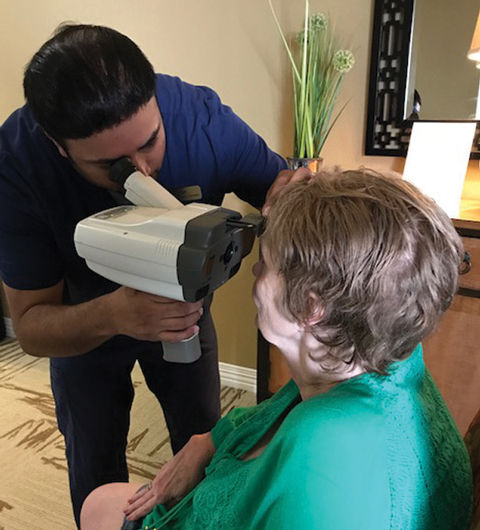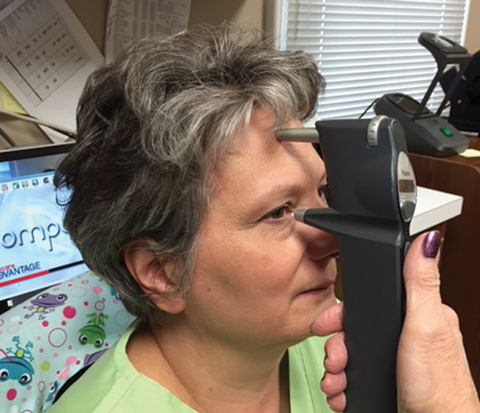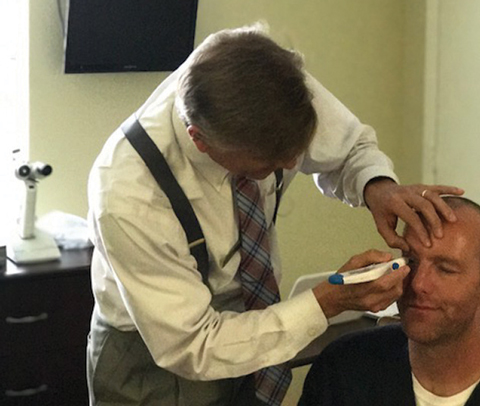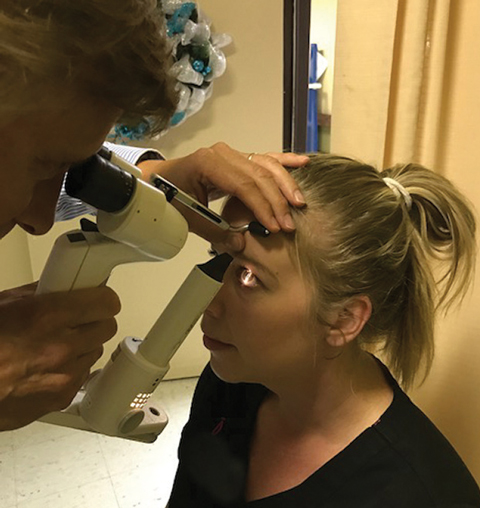40th Annual Technology ReportFollow the links below to read the other articles from our 40th annual Technology Report: How Early Diagnosis Can Improve AMD Outcomes Modernize Your Exam of Glaucoma Patients and Suspects Understanding Today's OCT Technology—And Anticipating Tomorrow's |
Convenience and portability are the drivers of much of today’s innovation, and now unlimited communication, information and entertainment are only the click of a button away. As consumers, our patients have come to expect the same seamless integration of technologies into health care.
In optometric practice, the push toward electronic health records (EHRs) and better technological integration has spurred innovation in diagnostic and patient management devices, including for refraction, intraocular pressure measurement and imaging of pathologies and anatomic variants, just to name a few.1
But with these new technologies comes increased expenses. In addition, each instrument has a footprint that has to fit into our sometimes-cramped office spaces with an ideal position for efficient use of time and space—not to mention designed with patient convenience and comfort in mind. That’s where portable technologies come in.
 |
| Portable autorefractors allow optometrists and their staff to obtain crucial data in any setting. Photo: Dan B. Shropshire, OD |
The Benefits of Minimization
Smaller instruments have saved the day for many working in tight spaces, and they can improve many aspects of practice, including:
Efficiency in the office. With handheld instruments, practitioners can overcome the limitations of space, allowing better time efficiencies and patient flow with no loss of volume or quality of diagnostic information. Handheld devices eliminate the need to move the patient from place to place or instrument to instrument during the work up. Using multiple portable devices allows several patients to receive testing simultaneously, and the practitioner can more efficiently review the information.
Flexibility outside the office. Handheld instruments free practitioners to provide much-needed care for patients who cannot come to the office. In states that allow mobile optometry, portable cameras, phoropters, autorefractors and slit lamps expand the patient base into nursing facilities and hospital rooms, for medical mission work and during emergencies as a valued first response team member.
Communication. More and more handheld instruments are adding the essential ability to communicate directly with EHRs while practitioners are caring for patients out of the office. The need for integrated care will drive continued improvement in this technology.
Profitability. The cost for most handheld devices is often less than the desktop mounted versions, and third-party reimbursements are the same as with the more expensive, larger instruments. In addition to these direct savings, proper use of handheld instruments can speed up pretesting and other data gathering, potentially increasing patient volume without sacrificing clinical services.
Because these instruments do not require extra room, small-office doctors can use them to increase their billable services, despite their current space limitations.
 |
| Handheld tonometers, such as the iCare, can make taking IOP readings a breeze. Photo: Nathan Stevens, OD |
There’s Always a Downside
While desk-mounted devices tend to rely less on the operator for quality data collection, the same is not true with handheld devices. Less-than-careful alignment and timing on the moment of data collection will lead to inaccurate or poor quality information when using a portable device. Practitioners will need extra time to first learn the proper use of the instrument and then to carefully train staff members.
Eye Care Goes InternationalHandheld ophthalmic instruments allow opportunities to provide eye care outside our traditional practices, including on humanitarian and mission ventures. These tools help health care practitioners provide vision care in impoverished areas—within our own communities or internationally—where medical care is not available due to lack of developed infrastructure or lack of economic resources. For example, I partner with my local church to provide much-needed eye care in the Dominican Republic and recently returned from a mission trip. With the use of handheld autorefractors, we assess the visual needs of three hundred people in just few days—a nearly impossible task with a retinoscope and loose lenses. We were free to travel to multiple locations within the country, and the battery capacity allowed us to perform screenings in areas without electricity. Also, the ease of use allowed others with little training to use the devices, which gave us the manpower to help hundreds of people in a limited time. |
Handheld devices are also more fragile than their desk-mounted counterparts. It’s nearly impossible to knock over and damage a desk-mounted device, but every use of a handheld instrument is an opportunity for it to be dropped, shaken or otherwise damaged.
While connectivity is improving for handheld instruments, desk-mounted devices are still more securely hard wired into today’s EHRs for immediate availability of information. Even as the technology improves, handheld devices will still require wifi or cloud-based technology for data transfer, which can increase security risks for the patient’s information.
Although handheld devices, including smartphones, can often improve data collection in small spaces, for special patient populations and outside the office, they may also cause disruption when used specifically for communication. One study looked at clinicians’ use of smartphones to communicate in a hospital setting and found it improves efficiency over the use of pagers.2 However, smartphone use also increases interruptions, creates a gap in perceived urgency, weakens interprofessional relationships and is linked to more unprofessional behavior.2 The researchers suggest that, while the technology has its benefits, improvements are necessary to balance the positives with the negatives.2
 |
| The Tono-Pen is another handheld tonometer that allows clinicians to check a patient’s IOP without bulky equipment or a designated testing area. Photo: Dan B. Shropshire, OD |
Handhelds in the Office
Here’s a look at some of the portable tools changing optometric practice:
Wavefront aberrometers. These devices are lost-cost options that often perform similarly to commercial autorefractors in objective refraction.3 Research suggests the need for more patient education, however. One study found clinicians must communicate that the measurement takes several seconds to complete—possibly limiting its utility with some patients.4
Autorefractors. Research suggests handheld autorefractors can provide refractive readings consistent with those captured with more traditional refractive techniques.5 One study assessed the refractive error, with and without cycloplegia, of 50 visually normal patients using a handheld autorefractor and compared the results with those obtained with retinoscopy, subjective refraction and two commercially available tabletop autorefractors.5 The results show the handheld device provided a refractive error not significantly different from the refractive error recorded by the other methods.5
Although older portable autorefractors were not useful for pediatrics, the same may not be the case with newer technology.6 New research found handheld autorefractors agree well with cycloplegic retinoscopy and noted they could be useful in screening pediatric patients ages four to 12, as they may eliminate the need for cycloplegia.7
Autorefractors are even becoming a smartphone accessory, which may be particularly useful in areas with limited access to eye care.8 These newer technologies are also providing expanded capabilities such as built-in fogging procedures to control for accommodation.9
Phoropters. While there is no reason clinicians would need to replace their in-office phoropter with a handheld one, a portable option is a must when visiting patients beyond the clinic. Many phoropters can be portable with a travel stand, but newer designs that put the phoropter in the patient’s hands removes the need for an extra stand.10
Tonometers. Many practices already use a handheld tonometer in practice. In one study, for example, the handheld PT100 tonometer (Reichert) was in agreement with traditional Goldmann applanation tonometry (GAT) within 3mm Hg or less in nearly 93% of eyes in normal patients.11 The devices can be particularly helpful for special patient populations as well, such as pediatrics. Another study found handheld rebound tonometry readings were likely to be accurate for children with normal eyes, sparing children an examination under anaesthesia.12 However, research does suggest handheld rebound tonometry frequently and significantly overestimates IOP compared with traditional GAT.12
Researchers also found acceptable agreement between GAT and the iCare handheld tonometer when testing adults, including control patients, automated-lamellar-therapeutic keratoplasty patients and Descemet-stripping-automated-endothelial keratoplasty patients.13 The agreement was poor in penetrating keratoplasty patients and those with an edematous graft.13 These researchers recommend clinicians suspect truly elevated IOP in patients with edematous graft when both GAT and handheld tonometry produce high IOP readings.13
 |
| Portable slit lamps are a must for examining patients unable to sit behind a traditional slit lamp or at a patient’s bedside outside the clinic. Photo: Dan B. Shropshire, OD |
Corneal topographers. These are great for measuring corneal shape and screening for corneal dystrophies, degenerations and irregularities.14,15 Researchers found readings from a handheld device were in agreement with traditional keratometry, but clinicians should perform topography in an upright position, as rotation can affect the data.16
Retinal imaging. Although retinal imaging is integral to the diagnosis and management of myriad ocular and systemic conditions, access to fundus photography can be limited by patient morbidity, high equipment cost and shortage of trained personnel.17 Portable options transcend these limitations and provide imaging capabilities regardless of patient—or practice—constraints.
Many investigators have studied the use of portable retinal camera screening for the progression of diabetic retinopathy (DR), for example.17-19 One study assessed 301 patients with Type 2 diabetes using standard seven-field digital fundus photography and a portable smartphone-based retinal imaging system.18 The investigators found the portable camera has substantial agreement with conventional retinal photography and is a good tool for screening and diagnosing DR and sight-threatening DR.18
Another study suggests portable retinal cameras, in conjunction with telemedicine technologies, can provide significant automation, sensitivity, specificity, portability and miniaturization for point-of-care diabetes diagnostics.19
Smartphone-based fundus cameras also allow clinicians to capture high-quality, widefield images that can be stored on the device and evaluated on site or transmitted for remote assessment.17
Optical coherence tomography (OCT). This is quickly becoming integral to any medical practice, but its footprint can be a limiting factor for some practices. Luckily, research suggests portable OCT imaging is comparable to images obtained with conventional OCT and can be useful for pediatric patients in particular.20 Investigators were able to obtain useful images from all 30 patients, ages seven months to almost 10.20 The portability allowed the researchers to obtain imaging without sedation in children as young as three years of age, and all children tolerated the tests well.20
Other investigators looked at the use of a handheld spectral-domain (SD) OCT device during macular surgery and found it is an efficient method for visualizing macular pathology.21 Although a small study of just eight patients, it suggests portable SD-OCT may help confirm or identify disease in some cases.21
Beyond Brick-and-mortarIn his strictly mobile nursing home practice that travels throughout the area surrounding Dallas, Texas, Dan B. Shropshire, OD, knows first-hand the wonderful benefits of handheld instruments in patient care. He and his highly trained team of optometrists and assistants provide exceptional and comprehensive eye care for this terribly underserved and growing demographic. “When I started one day a week back in 1996, there were not many handheld equipment choices,” says Dr. Shropshire. “But I loved my nursing home practice so much that I sold my private practice within six months and went full time into long-term care.” That kind of dedication took some imagination more than 20 years ago, when equipment ran big and bulky. But today, his practice has benefited from recent technological advances. “I began using a spot retinoscope with handheld lenses for my refractions, Schiotz tonometer for pressures and a corded BIO,” Dr. Shropshire says. “After acquiring my Tono-Pen, Nikon Retinomax and my battery-operated slit lamp and BIO, I was able to perform an exam very similar to any office.” When deciding on what equipment to incorporate into his practice, Dr. Shropshire focuses on what will ensure his patients receive the care that is as close to an in-office exam as possible. He also has to take into account his specific patient population: geriatrics. “There are many choices for each piece of equipment that I need,” he says. “Not all are appropriate for a geriatric population; my patients have poor fixation and cooperation. Add in poor positioning from kyphosis or being bed-bound, and these complexities will eliminate many of the choices out there. Trial and error will winnow out the practical from the impractical.” Regardless of equipment choice, the most important part of the equation is patient satisfaction. “I have been told time and again that my exam was the most thorough exam they ever had.” The secret to his success? The tools at his disposal in today’s market. “Without handheld instruments I would be going back to the ’50s—not so bad for movies and car designs, not good for eye care,” Dr. Shropshire jokes. “My practice runs as well as most practices, maybe even better, because of the convenience of handhelds. Without them it would be impractical.” |
Slit lamps. Portable slit lamps have been touted as indispensable in certain situations since the ’40s, as they can provide a “flexible aid in the diagnosis of more superficial pathologic changes, as well as a means of rapid and satisfactory inspection of minute foreign bodies.”23 Today, they can be used in the clinic for patients unable to sit behind a traditional slit lamp or at a patient’s bedside outside the clinic.
One study found smartphone ophthalmoscopy agreed substantially with slit-lamp examination when two masked glaucoma specialists estimated vertical cup-to-disc ratios in 110 patients with ocular hypertension or primary open-angle glaucoma.24 The researchers concluded smartphone ophthalmoscopy can be beneficial in glaucoma screening, especially in low-resource settings.24
Pachymeters. Researchers investigated the accuracy and repeatability of the SP-100 Handy (Tomey) portable pachymeter by assessing the corneal thickness of 57 right corneas of patients ages 18 to 44. They compared the results with readings obtained from two conventional pachymeters and found the handheld device provided reliable corneal thickness measurements, even when considering a single reading.25
While operator dependability is a concern for many devices, one study found a handheld pachymeter provided excellent intra-observer repeatability and inter-observer reproducibility by an ophthalmic nurse and an ophthalmologist.26
Electroretinogram (ERG). Even though electrodiagnostic testing isn’t common in an average optometric practice, a portable full-field ERG may eventually make it more feasible. Clinicians could potentially assess signs associated with many ocular conditions, such as DR, glaucoma and acquired and inherited retinal diseases, without shuffling patients around.27
Smartphone-based devices and apps. Many instruments are now integrated with smartphones, making them even more accessible. Practitioners can use their own device to capture anterior segment and retinal images, and even obtain autorefraction readings.5,8,17,19 In addition, the selection of ophthalmic apps is exploding to provide many testing and patient education options with just a swipe of a touchscreen. Amsler grid and color testing, vision therapy, blink exercises and basic eye exam readings are all available in an app to help practitioners test, follow and educate patients in the office and beyond.26,28
With ophthalmic technology, bigger isn’t always better. Downsizing equipment can reap significant rewards, especially for optometrists working with tight spaces and beyond their four walls. Smaller instruments can help to improve your office flow and bottom line—all while providing exceptional patient care.
Dr. Wimbish is co-founder and clinical director at Allen Eye Associates. He is interested in fitting medically indicated contact lenses for conditions such as keratoconus, corneal transplants and post refractive corneas. He primarily focuses on managing ocular surface disease within the multi-doctor private practice. He was voted Best Optometrist and Optometric Practice in his community the past four years.
He would like to thank Dan Shropshire, OD, for his contributions to this article.
| 1. American Medical Association. The HITECH act—an overview. Virtual Mentor. 2011;13(3):172-5. 2. Wu R, Rossos P, Quan S, et al. An evaluation of the use of smartphones to communicate between clinicians: a mixed-methods study. J Med Internet Res. 2011;13(3):e59. 3. Lage E, Vera-Diaz FA, Dave SR, et al. Evaluation of a low-cost wavefront aberrometer for measuring refractive errors. Invest Ophthalmol Vis Sci. 2014 April;55:2718. 4. Arafat S, Raubach M, Stetson G, et al. Assessing usability of the QuickSee: a novel portable wavefront aberrometer. NECO Public Health Poster Repository. 2016. 5. Ciuffreda KJ, Rosenfield M. Evaluation of the SVOne: a handheld, smartphone-based autorefractor. Optom Vis Sci. 2015;92(12):1133–9. 8. Wesemann W, Dick B. Accuracy and accommodation capability of a handheld autorefractor. J Cataract Refract Surg. 2000;26(1):62-70. 7. Yilmaz I, Ozkaya A, Alkin Z, et al. Comparison of the Plusoptix A09 and Retinomax K-Plus 3 with retinoscopy in children. J Ped Ophthalmol and Strabismus. 2015;52(1):37-42. 8. Solaka N, Modi R, Gaiser H, et al. Comparison of a new prototype of Netra-g cell phone-based refraction with subjective refraction. Invest Ophthalmol Vis Sci. 2014 April;55:2722. 9. EyeNetra. Smartphone autorefractor. https://store.eyenetra.com/products/netra-autorefractor-smartphone. Accessed August 4, 2017. 10. EyeNetra. Netropter. https://eyenetra.com/product-netropter.html. Accessed Augut 4, 2017. 11. Salim S, Linn DJ, Echols JR, Netland PA. Comparison of intraocular pressure measurements with the portable PT100 noncontact tonometer and Goldmann applanation tonometry. Clin Ophthalmol. 2009;3:341-4. 12. Dahlmann-Noor AH, Puertas R, Tabasa-Lim S, et al. Comparison of handheld rebound tonometry with Goldmann applanation tonometry in children with glaucoma: a cohort study. BMJ Open. 2013;3:e001788. 13. Salvetat ML, Zeppieri M, Miani F, et al. Comparison of iCare tonometer and Goldmann applanation tonometry in normal corneas and in eyes with automated lamellar and penetrating keratoplasty. Eye (Lond). 2011;25(5):642–50. 14. Bezner J, Karpecki PM. Can you identify these tricky topographies? Rev Optom. 2014;151(4):58-67. 15. Isenberg SJ, Del Signore M, Chen A, et al. Corneal topography of neonates and infants. Arch Ophthalmol. 2004;122(12):1767-71. 16. Lam AK, Chan R, Chiu R. Effect of instrument rotation on handheld keratometry. J Cataract Refract Surg. 2004;30(12):2590-4. 17. Maamari RN, Keenan JD, Fletcher DA, Margolis TP. A mobile phone-based retinal camera for portable wide field imaging. Br J Ophthalmol. 2014;98(4):438-41. 18. Rajalakshmi R, Arulmalar S, Usha M, et al. Validation of smartphone based retinal photography for diabetic retinopathy screening. PLoS One. 2015;10(9):e0138285. [Epub]. 19. DeBuc DC. The role of retinal imaging and portable screening devices in tele-ophthalmology applications for diabetic retinopathy management. Curr Diab Rep. 2016;16(12):132. 20. Gerth C, Zawadzki RJ, Héon E, Werner JS. High-resolution retinal imaging in young children using a handheld scanner and Fourier-domain optical coherence tomography. J AAPOS. 2009;13(1):72-4. 21. Dayani PN, Maldonado R, Farsiu S, Toth CA. Intraoperative use of handheld spectral domain optical coherence tomography imaging in macular surgery. Retina. 2009;29(10):1457-68. 22. Krimsky E. Portable slit lamp and its clinical value. Arch Ophthalmol. 1943;30(2):263-5. 23. Russo A, Mapham W, Turano R, et al. Comparison of smartphone ophthalmoscopy with slit-lamp biomicroscopy for grading vertical cup-to-disc ratio. J Glaucoma. 2016;25(9):e777-81. 24. Queirós A, González-Méijome JM, Fernandes P, et al. Technical note: Accuracy and repeatability of a new portable ultrasound pachymeter. Ophthalmic Physiol Opt. 2007;27(2):190-3. 25. Peyman M, Tai LY, Khaw KW, et al. Accutome PachPen handheld ultrasonic pachymeter: intraobserver repeatability and interobserver reproducibility by personnel of different training grades. Int Ophthalmol. 2015;35(5):651-5. 26. Baxter N. Eye-related apps. All About Vision. www.allaboutvision.com/apps. Accessed August 3, 2017. 27. Konan Medical. Reteval hand-held, full-field ERG. http://konanmedical.com/reteval. Accessed August 14, 2017. 28. Korb Blink Training App. https://itunes.apple.com/us/app/donald-korb-blink-training/id941412795?mt=8. Accessed August 3, 2017. |

